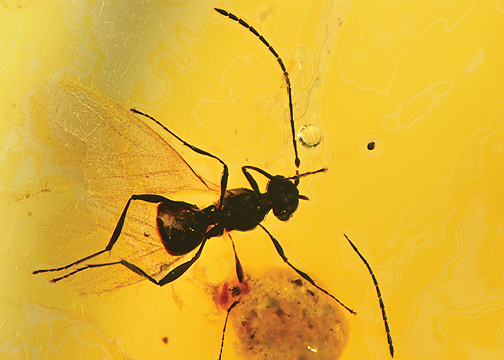Abstract
Although infrequent in the fossil record, the extinct wasp family Spathiopterygidae have been suggested to be diverse and globally distributed during the Cretaceous, being documented in seven major amber deposits. In the present study, I describe and figure Argemiones stupeflip gen. et sp. nov. from the rich early Cenomanian Kachin amber (Myanmar). The new monotypic genus is characterized by the compound eyes with numerous ommatidia, the first four flagellomeres distinctly thinner and longer than followings, a distinctive fore wing venation, a fringe of long setae along the apical margin of fore wing, a much reduced but present hind wing, and a conspicuous petiolate first metasomal segment. The presence of Spathiopterygidae in the endemic fauna of the Burma Terrane suggests their antiquity, with a possible origin in the Upper Jurassic to the earliest Cretaceous, and dispersion between the Gondwana and the Southern and Western Laurasia during the Lower Cretaceous. I propose an updated version of the key to genera and species of the family.
References
- Chen, J.N., Zhou, S.C, Wang, Y., Shi, M., Chen, X.X. & Huang, J.H. (2018) Biocontrol characteristics of the fruit fly pupal parasitoid Trichopria drosophilae (Hymenoptera: Diapriidae) emerging from different hosts. Scientific Reports, 8, 13323. https://doi.org/10.1038/s41598-018-31718-6
- Close, R.C., Moar, N.T., Tomlinson, A.I. & Lowe, A.D. (1978) Aerial dispersal of biological material from Australia to New Zealand. International Journal of Biometeorology, 22, 1–19. https://doi.org/10.1007/BF01553136
- Cruickshank, R.D. & Ko, K. (2003) Geology of amber locality in the Hukawng Valley, Northern Myanmar. Journal of Asian Earth Sciences, 2, 441–455. https://doi.org/10.1016/S1367-9120(02)00044-5
- Engel, M.S., Huang, D.Y., Azar, D., Nel, A., Davis, S.R., Alvarado, M. & Breitkreuz, L.C.V. (2015) The wasp family Spathiopterygidae in mid-Cretaceous amber from Myanmar (Hymenoptera: Diaprioidea). Comptes Rendus Palevol, 14, 95–100. http://dx.doi.org/10.1016/j.crpv.2014.11.002
- Engel, M.S., Ortega-Blanco, J., Soriano, C., Grimaldi, D.A. & Delclòs, X. (2013) A new lineage of enigmatic diaprioid wasps in Cretaceous amber (Hymenoptera: Diaprioidea). American Museum Novitates, 3771, 1–23. https://doi.org/10.1206/3771.2
- Ezcurra, M.D. & Agnolin, F.L. (2012) A new global palaeobiogeographical model for the Late Mesozoic and Early Tertiary. Systematic Biology, 61, 553–566. https://doi.org/10.1093/sysbio/syr115
- Grimaldi, D.A., Engel, M.S. & Nascimbene, P.C. (2002) Fossiliferous Cretaceous amber from Myanmar (Burma): its rediscovery, biotic diversity, and paleontological significance. American Museum Novitates, 3361, 1–72. https://doi.org/10.1206/0003-0082(2002)361<0001:FCAFMB>2.0.CO;2
- Krogmann, L., Azar, D., Rajaei, H. & Nel, A. (2016) Mymaropsis baabdaensis sp. n. from Lower Cretaceous Lebanese amber—the earliest spathiopterygid wasp and the first female known for the family. Comptes Rendus Palevol, 15, 483–487. https://doi.org/10.1016/j.crpv.2015.11.002
- Hardy, A.C. & Milne, P.S. (1938) Studies in the distribution of insects by aerial currents. Experiments in aerial tow-netting from kites. Journal of Animal Ecology, 7, 199–229. https://doi.org/10.2307/1156
- Labandeira, C.C. & Li, L. (2021) The history of insect parasitism and the Mid-Mesozoic Parasitoid Revolution. In: De Baeths, K. & Huntley, J.W. (Eds), The evolution and fossil record of parasitism: Identification and macroevolution of parasites. Topics in Geobiology, vol. 49. Springer, Cham, pp. 377–533. https://doi.org/10.1007/978-3-030-42484-8_11
- Masner, L. (1993) Superfamily Proctotrupoidea. In: Goulet H. & Huber J.T. (Eds), Hymenoptera of the World: An Identification Guide to Families. Research Branch Agriculture Canada, Ottawa, pp. 537–557.
- Peck, S.B. (1994) Aerial dispersal of Insects between and to islands in the Galápagos Archipelago, Ecuador. Annals of the Entomological Society of America, 87, 218–224. https://doi.org/10.1093/aesa/87.2.218
- Rasnitsyn, A.P. & Öhm-Kühnle, C. (2018) Three new females Aptenoperissus from mid-Cretaceous Burmese amber (Hymenoptera, Stephanoidea, Aptenoperissidae): unexpected diversity of paradoxical wasps suggests insular features of source biome. Cretaceous Research, 91, 168–175. https://doi.org/10.1016/j.cretres.2018.06.004
- Rasnitsyn, A.P. & Öhm-Kühnle, C. (2020) Taxonomic revision of the infraorder Proctotrupomorpha (Hymenoptera). Palaeoentomology, 3 (3), 223–234. https://doi.org/10.11646/palaeoentomology.3.3.2
- Ross, A.J. (2022) Burmese (Myanmar) amber taxa, online supplement v. 2022.1. 1–33. Available at: http://www.nms.ac.uk/explore/stories/natural-world/burmese-amber/ [accessed 28 January 2023]
- Santer, M., Álvarez-Parra, S., Nel, A., Peñalver, E. & Delclòs, X. (2022) New insights into the enigmatic Cretaceous family Spathiopterygidae (Hymenoptera: Diaprioidea). Cretaceous Research, 133, 105128. https://doi.org/10.1016/j.cretres.2021.105128
- Seton, M., Müller, R.D., Zahirovic, S., Gaina, C., Torsvik, T., Shepard, G., Talsma, A., Gurnis, M., Turner, M., Maus, S. & Chandler, M. (2012) Global continental and ocean basin reconstructions since 200 Ma. Earth-Science Reviews, 113, 212–270. https://doi.org/10.1016/j.earscirev.2012.03.002
- Sharkey, M.J., Carpenter, J.M., Vilhelmsen, L., Heraty, J., Liljeblad, J., Dowling, A.P., Schulmeister, S., Murray, D., Deans, A.R., Ronquist, F., Krogmann, L. & Wheeler, W.C. (2012) Phylogenetic relationships among superfamilies of Hymenoptera. Cladistics, 28, 80–112. https://doi.org/10.1111/j.1096-0031.2011.00366.x
- Shi, G.H., Grimaldi, D.A., Harlow, G.E., Wang, Ji, Wang, J., Yang, M.C., Lei, W.Y., Li, Q.L. & Li, X.H. (2012) Age constraint on Burmese amber based on U-Pb dating of zircons. Cretaceous Research, 37, 155–163. https://doi.org/10.1016/j.cretres.2012.03.014
- Smith, R.D.A. & Ross, A.J. (2017) Amberground pholadid bivalve borings and inclusions in Burmese amber: implications for proximity of resin producing forests to brackish waters, and the age of the amber. Earth and Environmental Science Transactions of the Royal Society of Edinburgh, 107, 1–9. https://doi.org/10.1017/S1755691017000287
- Szabó, M., Brazidec, M., Perrichot, V., Szenti, I., Kukovecz, Á. & Ősi, A. (2022) A unique record of the Late Cretaceous of East-Central Europe: The first fossil wasps (Hymenoptera: Bethylidae, Spathiopterygidae) from the ajkaite amber (Bakony Mts., western Hungary). Cretaceous Research, 139, 105314. https://doi.org/10.1016/j.cretres.2022.105314
- Westerweel, J., Roperch, P., Licht, A., Dupont-Nivet, G., Win, Z., Poblete, F., Ruffet, G., Swe, H.H., Thi, M.K. & Aung, D.W. (2019) Burma Terrane part of the Trans—Tethyan arc during collision with India according to palaeomagnetic data. Nature Geoscience, 12, 863–868. https://doi.org/10.1038/s41561-019-0443-2
- Yu, T.T., Kelly, R., Mu, L., Ross, A.J., Kennedy, J., Broly, P., Xia, F.Y., Zhang, H.C., Wang, B. & Dilcher, D. (2019) An ammonite trapped in Burmese amber. Proceedings of the National Academy of Sciences of the USA, 116, 11345–11350. https://doi.org/10.1073/pnas.1821292116
- Zhang, Q., Rasnitsyn, A.P., Wang, B. & Zhang, H.C. (2018) Hymenoptera (wasps, bees and ants) in mid-Cretaceous Burmese amber: A review of the fauna. Proceedings of the Geologists’ Association, 129, 736–747. https://doi.org/10.1016/j.pgeola.2018.06.004


